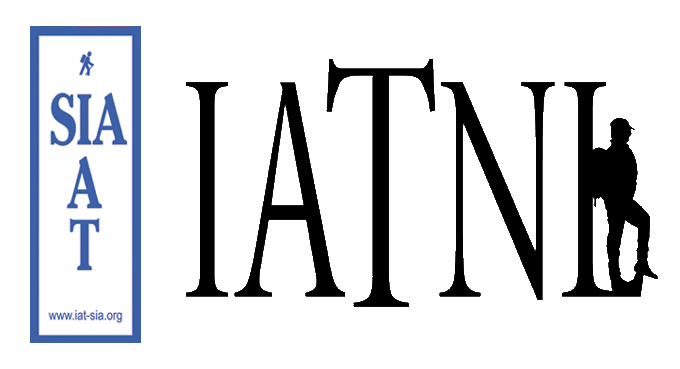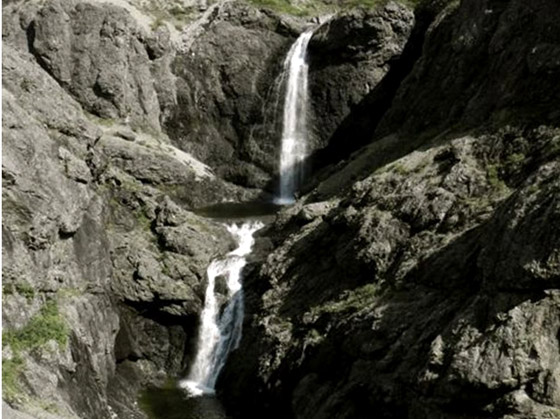Vermont Explorer Lew Coty recently put fingers to keyboard to recount his 2011 Western Newfoundland adventures. To follow – in his own words – is the first of two memorable treks:
August 1, 2010 This was the first day of a solo 4-day excursion around the IATNL’s Devil’s Bite and Indian Lookout loops. The Devil’s Bite is a local landmark that can be seen from many miles in all directions, and is located on the high ridge directly above the south shore of Parsons Inner Pond. It is a jagged u-shaped feature with protruding rocky spires that looks like a giant has taken a chomp out of the ridgeline. Unfortunately this feature did not show on my topographical map and much to my dismay I never found where it was located on this hike.
August 17, 2011 Late in the afternoon, after a very rainy day yesterday and this morning, the skies were clearing with nothing but blue skies showing to the west over the ocean. Strong west winds were bringing in this change of weather. I had just driven down Five Mile Road north of the town of Parson’s Pond, and was hiking east onto the Flat Hills following an IAT access trail. Devil’s Bite was my destination and this year I knew exactly where it was located and was determined to see it up close. The top of the Flat Hills were still enshrouded with clouds, but the late afternoon sun on the trail was bright and felt warm which helped ease the bite of the cold wind. My attention was drawn at intervals to the forest floor. Resting in the opaque green mat of ground vines were small white berries. They are called creeping snowberries, have a wintergreen flavor and I consider them to be the gourmet berry of Newfoundland. They make a splendid dessert though it is hard to find enough to fill up on.
I entered the clouds as soon I came to the barrens at the end of the trail, and upon reaching the top of the Flat Hills plateau I set up camp. I was watched through the fog by a snowshoe hare that seemed totally uninhibited in his cloak of mist.

August 18, 2011 I awoke to stronger winds than I had ever encountered in Newfoundland. They were making my tent dance. To make matters worse I was buried in a dense, gloomy fog that I knew would make navigation challenging. Breaking camp was difficult. If you didn’t have a solid grip on whatever you were repacking the wind would claim it. Wearing a hat was not an option. My sensible side screamed to head back but my goal-oriented stubbornness balked. The forecast had called for a sunny day and that is what I hoped to find as soon as I descended from the Flat Hills heading to Parsons Inner Pond.
Such was exactly the case. I don’t think sunshine has ever looked so good as when it first pierced that oppressive cloudbank. To the south, Parson’s Pond and its surrounding canyons and ridges sparkled in the cold clear air. The strong winds were buffeting the tenaciously clinging clouds above me and they were slowly breaking up.

I had an easy crossing of Middle Brook at its upper end where it drains Parson’s Inner Pond. The weather was complying with the forecast, and gazing up at the Devil’s Bite looming 2000ft above me I got it in my mind to be there at sunset. I was very close as the crow flies, but to get there I needed to go four kilometers south through Western Brook Gulch, climb up the head of this gulch to the upper alpine barrens and then hike four kilometers back north to the Bite. My pace accelerated. The Bite had become my siren and I was being lured to my fate.

Probably the hardest part of this route is climbing up out of Western Brook Gulch. Similar to the year before, I drifted into the brook that formed the upper end of this canyon and followed it up multiple cascades. It was late afternoon when I finally made it onto the highlands. The three kilometers left seemed to go on forever even though the hiking now was relatively easy. The sun was getting lower much too quickly. Visions of reddened setting rays shining through the Bite were dancing in my head, but I was having serious doubts about getting there in time. I found myself running (had I ever done that with a full backpack?) wherever the terrain allowed. On my left in the magic hour light were stunning views of a shimmering Parsons Pond draining into the ocean beyond, and v-shaped notches plummeting into Western Brook Gulch thousands of feet below. At times the mist from waterfalls hidden below the ridge was blown up by raging winds over the rim where it glistened in the setting sun before showering down on me. At last the entrance to the Bite was reached with about 30 minutes of daylight to spare!

My ecstasy was soon quenched as I realized how well-protected this feature was from casual exploring. I was standing on the leading edge of a very exposed ridge and it was taking full brunt of the winds sweeping across the flatlands from the ocean. Walking forward from here was a drunken swagger at best. Furthermore, getting to the rock spires that formed the Bite involved crossing a dense growth of tuckamore laced with a few deep crevasses. I managed to cross this moat and began bear-hugging my way up the narrow rounded backside of the first spire, fearing the gale-force winds might lift me like a kite at any moment. It was obvious I would never get my sunset photo from this position. There were enormous cliffs dropping off on both the east and west sides of the Bite, but fortunately in the middle was a shelf of fractured rock that could be accessed with some dicey scrambling. Though it is one of the most primordial locations I have ever visited, I felt strangely sheltered here as the wind wasn’t quite as ferocious, and I managed, with much excitement, to take a few photos of sunset through those majestic spires, moments before the sunlight was lost behind clouds on the western horizon.

I found another way out up a steep narrow slot filled with loose rock, avoiding the tuckamore moat. I quickly tried to find a tent-site on that narrow end of the ridge just south of the Bite as darkness ensued. I knew the relentless wind was going to be a big problem but I wasn’t about to stumble through the darkness under those conditions trying to find a more sheltered location. I found a spot toward the eastern side that was as wind shielded as I was going to find. Setting up my tent without losing it to the wind was a struggle. The soil was too shallow for reliable stake insertion. Fortunately this one-man tent, which is nothing more than a glorified bivy sack, has a low profile and I reinforced its stability by piling as many stones as I could find on the two main stakes that support its two short poles. To make matters worse, I could see patches of storm clouds to the west headed my way. I gulped down a handful of dinner gorp, put a rain cover over my pack and crawled into my shaking tent where I drifted into a restless sleep.
I was awakened several times by a hammering rain, hail and violent gusts of wind. One gust in particular shook the tent so ferociously it rolled me over. The tent body started flapping wildly with loud crackling noises and I knew the corner stakes had pulled. I was quite alarmed. My panicked intuition told me to immediately get out of this flimsy bubble I was zippered into before that unforgiving wind blew me over the nearest cliff, which wasn’t far leeward. Checking the poles revealed the main stakes had taken the hit and held. There was no place to go that would offer any more security. I again dozed fitfully in that rattling cocoon and had a dream the wind had rolled the pack and, filling the rain cover like a spinnaker, had hurled it into Parson’s Pond. In horror I thought of trying to return to my car without food or map or warm clothes. Finally at about 4 am the wind and squalls seemed to be burning themselves out and I slept soundly until 9 am.
8/19 I awoke sharply to full sunlight and a quiet tent. Most of the screening was covered solid with black flies. Much to my relief my pack was where I had left it. Trying to put food into my mouth through my head-net without letting bugs in was futile. If only I could have borrowed a little wind from the previous day. The morning fog was wandering through the cliffs that drop into Parsons Inner Pond fjord creating an ethereal scene.
I proceeded back across the highlands headed for Freake’s Waterfall, which is one of the highest in Newfoundland. As I approached Parsons Pond River that feeds this waterfall, and peered over the bank looking for a place to cross, I scared some young ducks hiding underneath the brim. They scurried into the white water directly above the lip of the falls and swam for their lives just to stay stationary. I was sure they were going to get sucked over that 1000ft drop but they somehow managed to hold their position firmly. I quickly headed upstream before they all had a heart attack.

8/20 In the early morning I was headed for three large ponds joined at the hip that feed into Little Gulch. I had weaved through multiple herds of caribou, in the same location that I had seen them a year ago, and was gingerly crossing an area of fragmented rock when my right foot slipped up to my knee into a small narrow fissure hidden by some low shrubs. Fortunately due to my cautious pace I sustained only minor bruises on my lower leg, but getting my leg and shoe out was a different story. I always wear river shoes (quick drain sneakers) on these excursions, which enabled me to wiggle my foot free from its shoe and pull it out. The shoe was left firmly wedged almost two feet down and getting it free turned problematic. The fissure was narrow and lined with sharp rock edges. I could not wrap my fingers around the shoe in such a way that I could really pull. I could grab the laces but when I pulled them hard I could feel the fabric tearing. I tried using a stick as a pry-bar with no better luck. The thought of walking for many kilometers across those rocky barrens with no shoe was unnerving. I tried again for about ten minutes in vain. Could I duck-tape some birch bark to my sole and make like an Indian? In desperation I gave it one last try and finally managed to wiggle the shoe sideways enough to pop it out.

In the early afternoon I had crossed the Flat Hills and arrived at Partridge Pond, which drains into another very large waterfall dropping into Southwest Feeder Gulch. I was told there was a good swimming pool on a small ledge half way down. Edging my way down under the brim of the falls I could indeed see a few dunking pools where the falls rested for a second before plunging again. Getting to these pools in a safe manner would be a serious challenge as they are surrounded by steep slippery ledge on all sides. I am left to wonder if anyone has actually swum there.

The way back from here was easy hiking over the northern end of the Flat Hills to the IAT access trail. This access is cut through the tuckamore at the base of the hills, and is marked with a large cairn at the top where it ends at the barrens. My hike ended as it had started in dense fog and my GPS was useful finding this cairn.
Lew Coty





